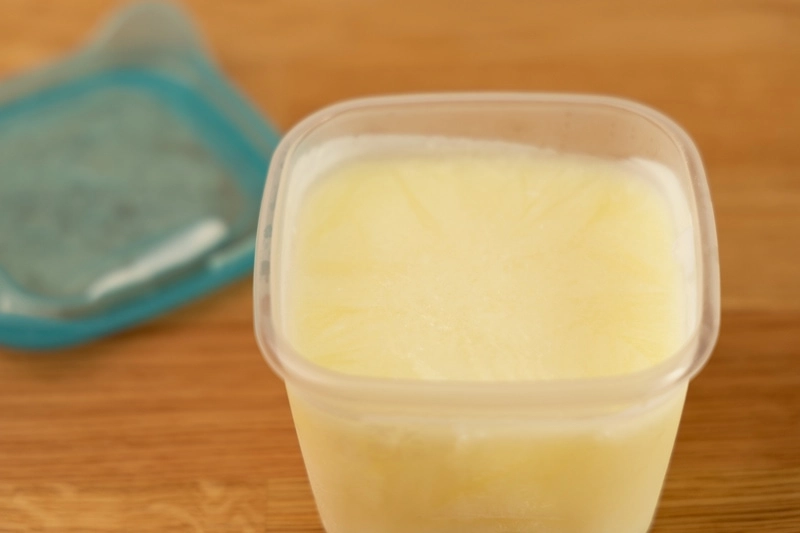Surely you already know that kefir is a dairy product very similar to liquid yogurt, fermented through the action of a set of yeasts and bacteria in the form of granules that give it the name “kefir”, which in Turkish means “blessing”. Due to this fermentation, this ancient food is key to protecting the intestines, since it has a probiotic that facilitates digestion and improves the body’s defenses, among other benefits. Likewise, kefir stands out for being rich in calcium, protein and vitamin B12.

Both water kefir and milk kefir are good for contracting and avoiding indigestion, candidiasis or constipation, as well as for stimulating the body’s defenses. However, once prepared it is necessary to consume it in a short period of time, which is usually around a week or week and a half. For this reason, it is common for us to ask ourselves how to serve kefir, what freezing methods exist and how we should defrost it afterwards. Well, in this article you will learn how to freeze and thaw kefir, along with some techniques and recommendations for its proper conservation.
How to store kefir?
Once you have prepared the kefir by filling the glass containers with fresh milk, in the case of milk kefir, or with water at room temperature, in the case of water kefir, and the kefir nodules, you must close the jars by covering the opening with a napkin or gauze and holding it with a rubber band. Next, let the kefir sit and rise in a dark, airtight place.
If you make the kefir at noon, by the night of the next day you will be able to consume it. To do this, you must strain the kefir, reserve the granules in a glass container and close the jar with milk or kefir water hermetically to store it in the fridge, just as you would with a yogurt. Kefir can also be kept in the fridge in plastic bottles, although we recommend opting for glass containers. In any case, kefir lasts up to 15 days. If you wish, you can mix it with sugar, with honey, with fruit smoothies, with nuts and with chocolate. However, if the objective of drinking kefir is to improve intestinal transit and maintain the figure, the ideal is to consume it without added sugar or honey to preserve its beneficial bacteria in better conditions.
If you have leftover kefir nodules or have to be away for a few days, the best way to preserve kefir is to submerge the nodules in milk and reserve the closed container in the refrigerator to slow fermentation for 4-5 days.
As you use the kefir grains, they grow. When the amount becomes excessive, it is necessary to remove the leftovers. Of course, do not throw them away! You can give them to a relative or a friend so that they can prepare their own kefir.
How to freeze kefir?
Can kefir be frozen? Of course! If you will be away for more than 5 days or simply do not feel like consuming this drink in a season, you can perfectly freeze the kefir grains to last up to 18 or even 19 months. To do this, you must first wash the kefir with water at room temperature, making sure that it does not fall too strongly on the granules. It is important that you wash it with water that is as free of chlorine and lime as possible and that you rinse it very carefully so as not to remove all its properties. Once washed, drain the kefir well in a non-metal strainer or sieve. To ensure that the nodules are free of liquid, you can let them drain for a few minutes.
Once drained, store the kefir grains in a glass container with a secure lid. You can also store the nodules in a plastic container from the supermarket with a lid, as long as it is tightly closed and prevents air from entering. In both cases, it is necessary to put the jar with the kefir in another glass container with a good sealing system to prevent the cold from penetrating directly and ending the life of the fungi.
It is recommended that you add the date of the day of its freezing in order to control that the kefir nodules do not remain frozen for more than 19 months, ideally defrosting them at 12. From time to time, you should open the container to release the natural gases of preparation (especially if it is milk kefir) and close again.
How to freeze milk kefir?
The freezing method explained is the same for freezing water kefir as milk kefir. The only difference is in the washing, since milk kefir will require a more thorough washing than water kefir. In this way, in both cases it is necessary to remove the granules from the liquid, wash them well, drain them as much as possible and put them in containers that will then be stored in a larger jar.
The important thing when freezing kefir is to ensure that the jars are hermetically sealed so that air does not enter. This is possible because the bacteria in kefir do not need oxygen.
Can kefir milk be frozen?
Kefir milk can be frozen in airtight glass jars, but it is not recommended. The ideal is to freeze the kefir grains and consume the kefir milk in the stipulated period of time. If you consider that you will not be able to consume it and you will have to discard it, and then freeze it.
Does frozen kefir lose properties?
No, frozen kefir does not lose its properties or benefits, so it is possible to subject it to this preservation method without any problem. Thus, it is possible to keep the kefir in perfect condition for longer and you can enjoy making this drink without difficulty, despite being away for days, weeks or months.
How to defrost kefir?
To thaw kefir grains and reactivate them, remove the container from the refrigerator and leave it overnight at room temperature to thaw on its own. If it is water kefir, it is convenient to avoid sunlight. The next day, drain the beans in a colander or sieve over a glass container. To drain the whey or liquid well, you can help yourself with a plastic or wooden spoon.
How to regenerate frozen kefir?
If it is milk kefir, once defrosted following the previous method you can put it in a new jar with milk. To do this, you do not need to wash the kefir, draining it is enough. Once in the jar or glass container with the fresh milk, cover the kefir with a kitchen napkin and let it rest at room temperature for at least two days. After this time you will be able to observe how it has fermented to the point of becoming a thick yogurt. To consume it, you will need to drain it again to remove the whey. This procedure can be repeated as many times as desired.
Now, if it is water kefir that has been frozen, the process of reactivating the fungus changes. Thus, after defrosting the kefir, it is necessary to drain it and place it in a container with water and sugar. The amount of sugar can be the usual amount to prepare the kefir water; however, it is important to note that after being frozen the fungus needs food, so it is convenient to add a little more sugar so that it regenerates faster.
Once regenerated, it is now possible to use kefir milk or water to consume or prepare recipes. For example, you can make a cake by following a yogurt cake recipe and substituting the yogurt for kefir milk, or use the water to make fruit juices for weight loss.



